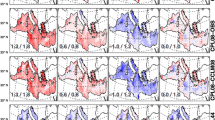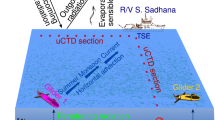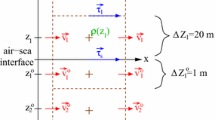Abstract
A revised algorithm for air–sea exchange parameterization of momentum, sensible and latent heat flux improves the climate simulation of the global distribution of sea surface temperature (SST) and tropical Pacific variability of SST. Based upon an analysis of studies from field programs, we apply the revised algorithm with new expressions for surface momentum and scalar roughness length dependent on 10-m winds in neutral condition, and evaluate them in the ocean–atmosphere coupled model of the Australian Community Climate and Earth-System Simulator. The revised algorithm improves simulations for mean global SST distribution, demonstrated with Pearson’s correlation indices showing corrections to a net fraction of 28 % over the global oceans. Being focused on the tropical Pacific, the algorithm eases the tropical SST cold tongue bias, and improves predictability of ENSO variability with better representations of the standard deviation of the Nino-3.4 index, especially the skewness of the index for nonlinearity of ENSO variability. Bjerknes and thermodynamical feedbacks are applied to understand the effects of the revised algorithm on the predictability of the Nino indices.





Similar content being viewed by others
Notes
Code version 7.3.
The ACCESS ocean model, ACCESS–OM, is a global coupled ocean and sea ice model consisting of the Geophysical Fluid Dynamics Laboratory Modular Ocean Model (GFDL MOM4) (Griffies 2007), the Los Alamos National Laboratory (LANL) sea ice model CICE4 (Hunke and Lipscomb 2010), a data atmospheric model, and the OASIS3.2-5 coupler.
z0s is used for both the sensible and latent heat fluxes.
References
An SI (2009) A review of interdecadal changes in the nonlinearity of the El Niño-Southern oscillation. Theor Appl Climatol 97:29–40
Andreas EL (2011) Fallacies of the enthalpy transfer coefficient over the Ocean in high winds. J Atmos Sci 68:1435–1445
Andreas EL, Persson POG, Hare JE (2008) A bulk turbulent air–sea flux algorithm for high-wind, spray conditions. J Phys Oceanogr 38:1581–1596
Andreas EL, Mahrt L, Vickers D (2012) A new drag relation for aerodynamically rough flow over the Ocean. J Atmos Sci 69:2520–2537
Beljaars ACM (1995) The parametrization of surface fluxes in large-scale models under free convection. Q J R Meteorol Soc 121:255–270
Beljaars ACM, Holtslag AAM (1991) Flux parameterization over land surfaces for atmospheric models. J Appl Meteorol 30:327–341
Bi D, Dix M, Marsland SJ, O’Farrell1S, Rashid HA, Uotila P, Hirst AC, Kowalczyk E, Golebiewski M, Sullivan1 A, Yan H, Hannah N, Franklin C, Sun Z, Vohralik P, Watterson I, Zhou X, Fiedler R, Collier M, Ma Y, Noonan J, Stevens L, Uhe P, Zhu H, Griffies SM, Hill R, Harris C, Puri K (2013a) The ACCESS coupled model: description, control climate and evaluation. Aust Met Ocean J 63 41–64
Bi B, Marsland SJ, Uotila1 P, O’Farrell1 S, Fiedler R, Sullivan A, Griffies SM, Zhou X, Hirst AC (2013b) ACCESS-OM: the ocean and sea-ice core of the ACCESS coupled model. Aust Met Ocean J 63:213–312
Bjerknes J (1969) Atmospheric teleconnections from the equatorial pacific. Mon Wea Rev 97:163–172
Charnock H (1955) Wind stress on a water surface. Quart J R Meteorol Soc 81:639–640
Chen D, Busalacchi AJ, Rothstein LM (1994) The roles of vertical mixing, solar radiation, and wind stress in a model simulation of the sea surface temperature seasonal cycle in the tropical Pacific Ocean. J Geophys Res 99:20345–20359
Csanady GT (2001) Air–sea interaction: laws and mechanisms. Cambridge University Press, Cambridge, p 239
Delworth TL et al (2006) GFDL’s CM2 global coupled climate models. Part I: formulation and simulation characteristics. J Clim 19:643–674
Donelan MA (1982) The dependence of the aerodynamic dragcoefficient on wave parameters. In: First international conference on meteorology and air–sea interaction of the coastal zone, The Hague, Netherlands, American Meteorological Society, pp 381–387
Drennan WM, Taylor PK, Yelland MJ (2005) Parameterizing the sea surface roughness. J Phys Oceanogr 35:835–848
Dyer AJ (1974) A review of flux-profile relationships. Bound Layer Meteorol 7:363–372
Edwards JM (2007) Oceanic latent heat fluxes: consistency with the atmospheric hydrological and energy cycles and general circulation modelling. J Geophy Res 112:D06115
Fairall CW, Larsen SE (1986) Inertial-dissipation methods and turbulent fluxes at the air-ocean interface. Bound Layer Meteorol 34:287–301
Fairall CW, Bradley EF, Godfrey JS, Wick GA, Edson JB, Young GS (1996) Cool skin and warm layer effects on the sea surface temperature. J Geophys Res 101:1295–1308
Fairall CW, Bradley EF, Hare JE, Grachev AA, Edson JB (2003) Bulk parameterization of air-sea fluxes: updates and verification for the COARE algorithm. J Clim 16:571–591
Fairall CW, Banner ML, Peirson WL, Asher W, Morison RP (2009) Investigation of the physical scaling of sea spray spume droplet production. J Geophys Res: Oceans 114:C10001
Garratt JR (1994) The atmospheric boundary layer. Cambridge University Press, Cambridge, p 316
Griffies SM (2007) Elements of MOM4p1. GFDL Ocean group technical report no. 6, NOAA/geophysical fluid dynamics laboratory, Princeton, NJ, 369 pp
Hannachi A, Stephenson D, Sperber K (2003) Probability-based methods for quantifying nonlinearity in the ENSO. Clim Dyn 20:241–256
Hewitt HT, Copsey D, Culverwell ID, Harris CM, Hill RSR, Keen AB, McLaren A, Hunke EC (2011) Design and implementation of the infrastructure of HadGEM3: the next-generation Met Office climate modelling system. Geosci Model Dev 4:223–253
Huang B, Schneider EK (1995) The response of an Ocean general circulation model to surface wind stress produced by an atmospheric general circulation model. Mon Wea Rev 123:3059–3085
Hunke EC, Lipscomb WH (2010) CICE: the Los Alamos sea ice model documentation and software user’s manual, Version 4.1, LA-CC-06-012, Los Alamos National Laboratory, NM, 76 pp
Jin FF (1997) An equatorial ocean recharge paradigm for ENSO. Part I: conceptual model. J Atmos Sci 54:811–829
Jungclaus JH, Keenlyside N, Botzet M, Haak H, Luo JJ, Latif M, Marotzke J, Mikolajewicz U, Roeckner E (2006) Ocean circulation and tropical variability in the coupled model ECHAM5/MPI-OM. J Clim 19:3952–3972
Kowalczyk EA, Stevens L, Law RM, Dix M, Wang YP, Harman IN, Haynes K, Srbinovsky J, Pak B, Ziehn T (2013) The land surface model component of ACCESS: description and impact on the simulated surface climatology. Aust Met Ocean J 63:65–82
Large WG, Pond S (1982) Sensible and latent heat flux measurements over the Ocean. J Phys Oceanogr 12:464–482
Lin JL (2007) The double-ITCZ problem in IPCC AR4 coupled GCMs: ocean–atmosphere feedback analysis. J Clim 20:4497–4525
Liu WT, Businger JA (1975) Temperature profile in the molecular sublayer near the interface of a fluid in turbulent motion. Geophys Res Lett 2:403–404
Lloyd J, Guilyardi E, Weller H, Slingo J (2009) The role of atmosphere feedbacks during ENSO in the CMIP3 models. Atmos Sci Lett 10:170–176
Lloyd J, Guilyardi E, Weller H (2011) The role of atmosphere feedbacks during ENSO in the CMIP3 models. Part II: using AMIP runs to understand the heat flux feedback mechanisms. Clim Dyn 37:1271–1292
Luo JJ, Masson S, Roeckner E, Madec G, Yamagata T (2005) Reducing climatology bias in an ocean–atmosphere CGCM with improved coupling physics. J Clim 18:2344–2360
Peixoto JP, Oort AH (1992) Physics of climate. Spring-Verlag, New York, p 520
Roberts MJ Coauthors (2004) Impact of an Eddy-permitting ocean resolution on control and climate change simulations with a global coupled GCM. J Clim 17:3–20
Shinoda T (2005) Impact of the diurnal cycle of solar radiation on intraseasonal SST variability in the western equatorial Pacific. J Clim 18:2628–2636
Smith SD (1988) Coefficients for sea surface wind stress, heat flux, and wind profiles as a function of wind speed and temperature. J Geophys Res 93:15467–15472
Smith SD et al (1992) Sea surface wind stress and drag coefficients: the HEXOS results. Bound Layer Meteorol 60:109–142
Song X, Zhang GJ (2009) Convection parameterization, tropical Pacific double ITCZ, and upper-ocean biases in the NCAR CCSM3. Part I: climatology and atmospheric feedback. J Clim 22:4299–4315
Trenberth KE (1997) The definition of El Niño. Bull Amer Meteor Soc 78:2771–2777
Valcke S (2006) OASIS3 user guide (prism 2-5). PRISM Support Initiative No 3, 68 pp
Wang Y, Kepert JD, Holland GJ (2001) The effect of sea spray evaporation on tropical cyclone boundary layer structure and intensity. Mon Wea Rev 129:2481–2500
Wilson DR, Bushell AC, Kerr-Munslow AM, Price JD, Morcrette CJ (2008) PC2: a prognostic cloud fraction and condensation scheme. I: scheme description. Q J R Meteorol Soc 134:2093–2107
Wu J (1980) Wind-stress coefficients over sea surface near neutral conditions—a revisit. J Phys Oceanogr 10:727–740
Yelland M, Taylor PK (1996) Wind stress measurements from the open ocean. J Phys Oceanogr 26:541–558
Yelland MJ, Moat BI, Taylor PK, Pascal RW, Hutchings J, Cornell VC (1998) Wind stress measurements from the open ocean corrected for airflow distortion by the ship. J Phys Oceanogr 28:1511–1526
Acknowledgments
Yimin Ma benefited from discussions with Drs. Arian Lock and John Edwards of the UK MetOffice during the early stage of this study, and is grateful for constructive suggestions by an anonymous reviewer. The study is supported by the ACCESS model development project of the Australian Bureau of Meteorology and CSIRO, and by the Australian Climate Change Science Program (an Australian Government initiative). Drs. Noel Davidson, Vaughan Barras and Savin Chand reviewed the manuscript and made comments that improved the manuscript.
Author information
Authors and Affiliations
Corresponding author
Rights and permissions
About this article
Cite this article
Ma, Y., Zhou, X., Bi, D. et al. Improved air–sea flux algorithms in an ocean–atmosphere coupled model for simulation of global ocean SST and its tropical Pacific variability. Clim Dyn 44, 1473–1485 (2015). https://doi.org/10.1007/s00382-014-2281-7
Received:
Accepted:
Published:
Issue Date:
DOI: https://doi.org/10.1007/s00382-014-2281-7




